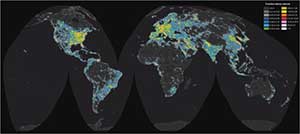A monthly recap of papers selected by the editors of Physics.
August 1, 2016
To get the best view of a pristine night sky, you may have to travel far beyond city limits. Quantifying the extent of light pollution on a global scale, Falchi et al. report in Science Advances that the Milky Way is hidden from one-third of humanity. The Day Night Band (DNB) sensor aboard the Visible Infrared Imaging Radiometer Suite (VIIRS) is a high-resolution detector, capable of measuring the glow of vibrant cities from an altitude of 500 miles above the Earth’s surface. Averaging newly calibrated DNB data from select months in 2014, the team compiled a “world atlas” of artificial sky luminance. The atlas provides a global map of the zenith sky brightness (that is, directly overhead — generally the darkest part of the sky) to outline the locations that are the most impacted by artificial sky glow. The visual effects of light pollution are extensive — 60% of the European Union population and nearly 80% of the United States population never experience a true view of the Milky Way, which is masked by an artificial twilight. Some communities — Middle Eastern countries in particular — experience extreme amounts of light pollution, where the majority of the population lives under skies so bright that the eye never adapts to pure night vision.
See the Physics website for Editors’ Choice highlights on the physics of chocolate, 3D printing tiny lenses, and more.

Image: Falchi et al. Science Advances (2016)
A sky map quantifies light pollution on a global scale.

